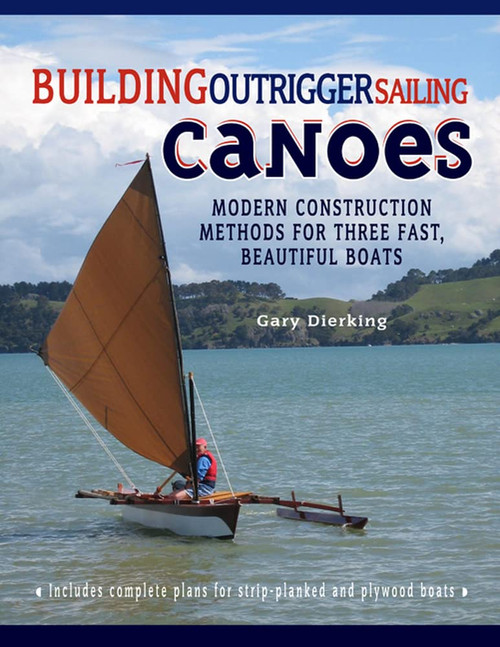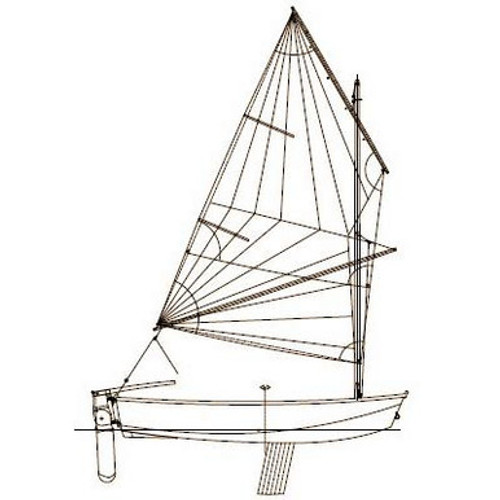Note: "Photos of various types and configurations of mini outriggers on various sailing canoes in German RAID event - Photographer - Koos Winnips"
That is 1/8 to 5/32" with maximum of less than 1/4"
Hull Length – <4ft (1.2m)
Volume – 50lbs (22kg)
Weight – 5lbs if 3 or 4mm Gaboon Plywood. More with other plywood
Crossbeam
Length – Beam/width of middle hull + 1650mm (Beam/width of middle hull + 65″)
Material – Fir or other medium density timber
- Boat is sailed to keep the outriggers out of the water. If the boat is sailed with outriggers in the water then the sailor will never improve.
- Speed of the normal boat is not reduced if sailed with Amas out of the water.
- For experienced sailors the outriggers provide a greater margin of safety for more adventurous sailing
- The volume is low enough (22kg/50lbs) that if there is a capsize the outriggers can be sunk with body weight to right the boat.
- The short length and low volume allows a single crossbeam to be used to minimise clutter of the cockpit.
- There is no lamination required for the crossbeam. Simple 6:1 scarf is used to create the dihedral angle.
- When not needed they can be left off.
- Will stow inside many canoes, pickups and wagons
- The method for mounting the crossbeams to the main hull is only covered by suggestions as there will be too many variations.
THE DROP-IN MINI OUTRIGGERS – DESIGNER'S COMMENTS
The Mini Outriggers are to add stability to a sailing canoe and help reduce the risk of capsize on other relatively slender boats. They are set above the water to allow a sailing canoe or narrow dinghy to be sailed normally and are intended only to touch down when heel exceeds a certain amount.
Because the capsize behaviour of your boat will changed A LOT – we strongly recommend practicing capsize and recovery. More information on this website page. Theory is worth nothing – you really have to practice so you know what is required for your boat and your body weight and ability.
Crossbeam
Length – Beam/width of middle hull + 1650mm (Beam/width of middle hull + 65″)
Material – Fir, Pine or other medium density timber with no knots and straight grain
There are many applications for the Mini Outriggers for Canoes and kayaks. From beginners to allowing an extra margin of safety to experienced sailors doing more adventurous sailing
What The Mini Outriggers For Canoes Don’t Do For Beginner (Canoe) Sailors
For learners and those new to Sailing Canoes, the outrigger hulls do not have sufficient volume for sailing full time with one of the outriggers in the water.
If you want to progress in sailing then every time the outrigger touches the water is a FAIL. It means that you have not adjusted your hiking position or trimmed the sail soon enough.
If you use the outriggers in this way – as a warning that what you are doing is not good technique - then you will progress in your sailing as if the outriggers are not there.
If wanting to sail full time on outriggers then they need to be longer and more slender. And they need two crossbeams because one is not enough when the hulls are longer. I have the Drop In Outrigger Plan for full time sailing on the outrigger hull.
See our plan for the Drop In Outriggers for more volume and length.
What The Mini Outriggers For Canoes Don’t Do For Intermediate Level Sailors
One of the trademarks of Experienced Sailors is that they know what not to do. And they know and have tested all their gear.
They will be practiced in a wide range of conditions … without the outriggers. But they use the outriggers to reduce the problems if something goes wrong or something unexpected happens.
Intermediate sailors must remember that they should only go out in conditions that they would normally go out in. The outriggers will not save you from capsize if a serious mistake is made.















